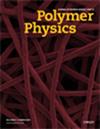聚羟基丁酸酯和聚丙烯酸甲酯共混物的混相、结晶动力学和形貌
3区 工程技术
Q1 Materials Science
Journal of Polymer Science. Part B, Polymer Physics
Pub Date : 2000-07-15
DOI:10.1002/1099-0488(20000715)38:14<1860::AID-POLB40>3.0.CO;2-#
引用次数: 23
摘要
采用差示扫描量热法、光学显微镜和小角度x射线散射(SAXS)研究了聚β-羟基丁酸酯(PHB)和聚丙烯酸甲酯(PMA)二元共混物的混相、球晶生长动力学和形貌。随着共混物中PMA含量的增加,玻璃化转变温度和冷结晶温度升高,但熔点降低。PHB与PMA的相互作用参数为- 0.074,由平衡熔点下降分析得到。无定形PMA组分的存在降低了PHB的球晶生长速率。用Lauritzen-Hoffman模型分析了球晶的径向生长速率。PHB的球晶充满体积,表明球晶中含有PMA。SAXS测得的长周期随PMA含量的增加而增加,说明在PHB结晶过程中,无定形PMA被包裹在PHB的层间区。结果表明,PHB和PMA在熔体中存在混相。©2000 John Wiley & Sons, Inc[J]生物质化学工程学报,2009,31 (2):559 - 567本文章由计算机程序翻译,如有差异,请以英文原文为准。
Miscibility, crystallization kinetics, and morphology of poly(?-hydroxybutyrate) and poly(methyl acrylate) blends
The miscibility, spherulite growth kinetics, and morphology of binary blends of poly(β-hydroxybutyrate) (PHB) and poly(methyl acrylate) (PMA) were studied with differential scanning calorimetry, optical microscopy, and small-angle X-ray scattering (SAXS). As the PMA content increases in the blends, the glass-transition temperature and cold-crystallization temperature increase, but the melting point decreases. The interaction parameter between PHB and PMA, obtained from an analysis of the equilibrium-melting-point depression, is −0.074. The presence of an amorphous PMA component results in a reduction in the rate of spherulite growth of PHB. The radial growth rates of spherulites were analyzed with the Lauritzen–Hoffman model. The spherulites of PHB were volume-filled, indicating the inclusion of PMA within the spherulites. The long period obtained from SAXS increases with increased PMA content, implying that the amorphous PMA is entrapped in the interlamellar region of PHB during the crystallization process of PHB. All the results presented show that PHB and PMA are miscible in the melt. © 2000 John Wiley & Sons, Inc. J Polym Sci B: Polym Phys 38: 1860–1867, 2000
求助全文
通过发布文献求助,成功后即可免费获取论文全文。
去求助
来源期刊
CiteScore
5.90
自引率
0.00%
发文量
0
审稿时长
2.1 months
期刊介绍:
Since its launch in 1946 by P. M. Doty, H. Mark, and C.C. Price, the Journal of Polymer Science has provided a continuous forum for the dissemination of thoroughly peer-reviewed, fundamental, international research into the preparation and properties of macromolecules.
From January 2020, the Journal of Polymer Science, Part A: Polymer Chemistry and Journal of Polymer Science, Part B: Polymer Physics will be published as one journal, the Journal of Polymer Science. The merged journal will reflect the nature of today''s polymer science research, with physics and chemistry of polymer systems at the heart of the scope.
You can continue looking forward to an exciting mix of comprehensive reviews, visionary insights, high-impact communications, and full papers that represent the rapid multidisciplinary developments in polymer science.
Our editorial team consists of a mix of well-known academic editors and full-time professional editors who ensure fast, professional peer review of your contribution. After publication, our team will work to ensure that your paper receives the recognition it deserves by your peers and the broader scientific community.

 求助内容:
求助内容: 应助结果提醒方式:
应助结果提醒方式:


